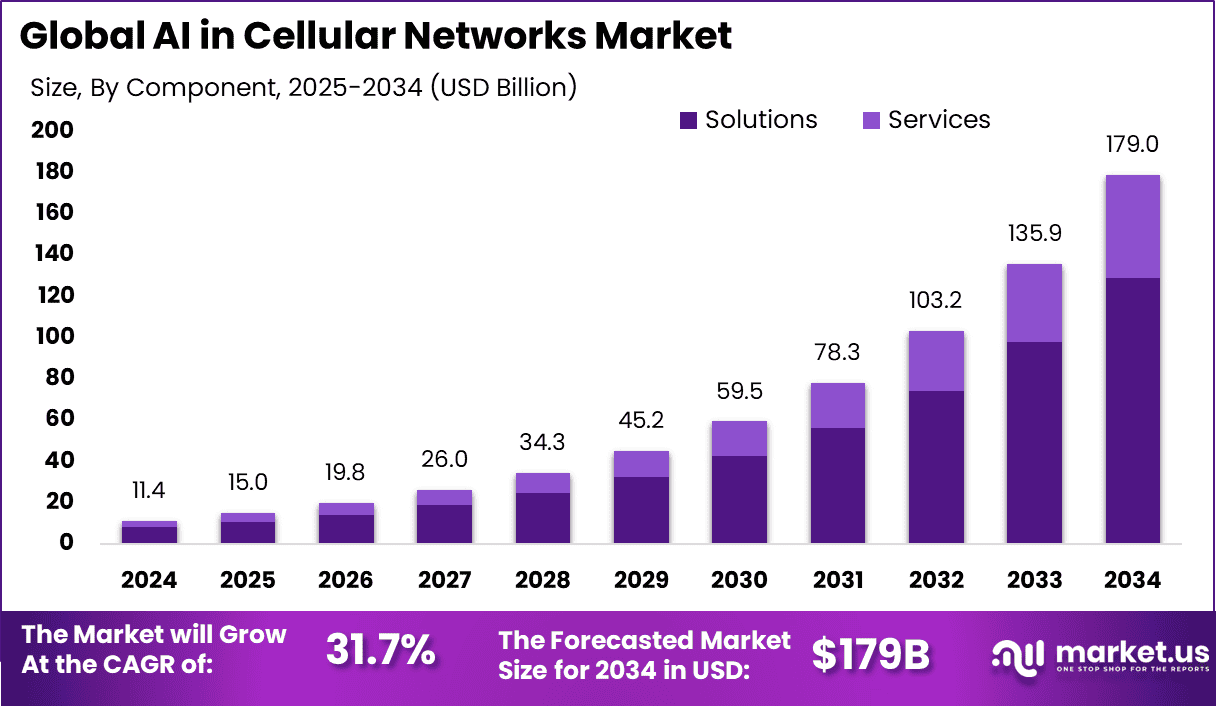Table of Contents
The Global AI in Cellular Networks Market is projected to expand from USD 11.4 billion in 2024 to USD 179 billion by 2034, growing at a robust CAGR of 31.7% between 2025 and 2034. This growth is propelled by increasing adoption of AI technologies to optimize network management, enhance security, and improve customer experience amid growing demand for faster and more reliable cellular connectivity. In 2024, North America dominated with a 35.6% market share, generating USD 4.0 billion in revenue, with the U.S. market valued at USD 3.8 billion and growing at 29.4% CAGR.

How Tariffs Are Impacting the Economy
Tariffs on imported telecom hardware, semiconductor components, and AI-specific devices essential for cellular network infrastructure have raised capital costs for network operators and equipment manufacturers. U.S. tariffs, particularly on imports from China and other Asian countries, have increased prices for routers, base stations, and AI chips, leading to higher expenses in network upgrades and AI integration projects.
➤ Discover how our research uncovers business opportunities @ https://market.us/report/ai-in-cellular-networks-market/free-sample/
(Use corporate mail ID for quicker response)
These tariffs disrupt global supply chains, causing procurement delays and inflating operational budgets. Increased costs may slow infrastructure deployment, particularly in rural and developing regions, impacting the pace of digital inclusion and economic growth. While tariffs aim to bolster domestic production, they add inflationary pressures and uncertainty that could hinder the rapid expansion and innovation in cellular AI technologies.

Impact on Global Businesses
Global telecom companies face escalating hardware and component costs due to tariffs, affecting budgets for AI-enabled network upgrades. The rising expenses challenge operators’ ability to deploy next-gen cellular infrastructure efficiently. Industries reliant on high-speed connectivity, including IoT, autonomous vehicles, and streaming, experience potential service delays. Supply chain disruptions are causing strategic shifts towards regional sourcing and local manufacturing investments. AI solution providers must navigate these challenges to maintain innovation cycles. Businesses in tariff-exempt regions or with diversified supply networks are better positioned to sustain growth and capitalize on AI-driven cellular network advancements.
Strategies for Businesses
To mitigate tariff impacts, companies are:
- Diversifying supply chains globally
- Increasing investments in local manufacturing
- Accelerating adoption of cloud-based AI solutions to reduce hardware dependency
- Engaging in advocacy for tariff relief
- Enhancing supply chain transparency with digital technologies
These strategies support resilience and sustained innovation amid trade uncertainties.
Take advantage of our unbeatable offer - buy now!

Key Takeaways
- Market growing at 31.7% CAGR through 2034
- Tariffs raise telecom hardware costs, slowing deployment
- Supply chain diversification and localization mitigate risks
- Cloud AI reduces hardware dependency
- Policy engagement is vital to ease trade barriers
➤ Get full access now @ https://market.us/purchase-report/?report_id=148609
Analyst Viewpoint
Despite tariff-induced challenges, the AI in Cellular Networks market exhibits strong growth potential driven by 5G rollout and increasing demand for intelligent network automation. Companies prioritizing supply chain agility and cloud-based AI will outperform peers. Emerging technologies like edge AI and network slicing will propel innovation. Trade policy stabilization is expected to reduce disruptions, supporting faster deployment and expanding market opportunities. The outlook remains positive as AI becomes integral to cellular network evolution.
Regional Analysis
North America leads the market with 35.6% share, driven by advanced telecom infrastructure and AI research investment. Europe follows with focus on regulatory compliance and digital transformation. Asia-Pacific is the fastest-growing region due to rapid 5G adoption, expanding IoT ecosystems, and government support in China, India, and Japan. Latin America and the Middle East are emerging markets with increasing infrastructure investments and AI adoption in cellular networks.
➤ Discover More Trending Research
- Database Security Market
- Cross-Border E-Commerce Logistics Market
- B2B Electronic Commerce Market
- E-Commerce Payment Market
Business Opportunities
Opportunities arise from the need for AI-powered network optimization, predictive maintenance, and enhanced security in cellular networks. Growth in IoT devices and connected vehicles increases demand for reliable AI-driven connectivity. Cloud AI platforms offer scalable solutions to telecom operators. Emerging economies provide prospects for infrastructure upgrades. Partnerships between AI vendors and telecom providers create avenues for innovative service offerings, fueling growth in network automation and customer experience enhancement.
Key Segmentation
Segments include:
By Technology
- Machine Learning
- Deep Learning
- Natural Language Processing
- Computer Vision
By Application
- Network Optimization
- Predictive Maintenance
- Security & Threat Detection
- Customer Experience Management
By Deployment
- On-Premise
- Cloud-Based
- Hybrid
By Region
- North America
- Europe
- Asia-Pacific
- Latin America
- Middle East & Africa
Each segment is driven by specific industry needs and technology trends.
Key Player Analysis
Market leaders focus on integrating AI with 5G infrastructure, emphasizing automation and security. Strategic partnerships with cloud providers and equipment manufacturers enhance capabilities. Heavy investment in R&D targets scalable, real-time AI solutions that improve network efficiency and customer satisfaction. Compliance with data privacy and telecom regulations remains a priority. Differentiation arises from offering comprehensive AI-driven platforms with strong support and customization options.
Recent Developments
In 2024, leading companies launched AI-powered network management platforms integrated with 5G technologies and formed alliances with cloud service providers to boost scalability and reduce latency.
Conclusion
The Global AI in Cellular Networks Market is on a robust growth trajectory, driven by increasing AI adoption and 5G expansion. Businesses adopting flexible supply chains, cloud AI solutions, and innovation will be best positioned to capitalize on this growing market despite tariff challenges.
Discuss your needs with our analyst
Please share your requirements with more details so our analyst can check if they can solve your problem(s)



